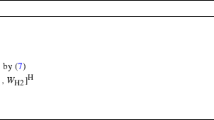Abstract
A combined iteration algorithm based on the bordering and conjugate gradient methods is proposed to solve systems of linear equations generated by the finite element method in the plate bending problem. The numerical results for the analysis of the convergence rate of the iterative process are presented in the solution of model problems using a classical and modified algorithm of the method of conjugate gradients. The possibility of acceleration of the iterative algorithm is shown.
Similar content being viewed by others
References
G. Meurant, Computer Solution of Large Linear Systems. Studies in Mathematics and Its Applications, Amsterdam; Lausanne; New York; Oxford; Shannon; Singapore; Tokyo (1999).
A. George and J. Lew, Numerical Solution of Large Sparse Systems of Equations [ Russian translation], Mir, Moscow (1984).
S. Pissanetsky, Sparse Matrix Technology [Russian translation], Mir, Moscow (1988).
L. Heigeman and D. Yang, Applied Iterative Methods [Russian translation], Mir, Moscow (1986).
M. Hestens and E. Stiefel, “Methods of conjugate gradients for solving linear systems,” Nat. Bur. Std. J. Res., 49, 409–436 (1952).
J. K. Reid, “On the method of conjugate gradients for the solution of large sparse systems of linear equations,” in: Large Sparse Sets of Linear Equations, Academic Press, London; New York (1971), pp. 231–252.
E. G. D’yakonov, “About some direct and iterative methods based on the matrix bordering,” in: G. I. Marchuk (Ed.), Numerical Methods in the Mathematical Physics [in Russian], Siberian Department of the Ac. Sci. USSR, Novosibirsk (1979), pp. 45–68.
A. M. Matsokin and S. V. Nepomnyashchikh, “Application of the bordering in the solution of mesh systems of equations,” in: Computational Algorithms in Problems of the Mathematical Physics [in Russian], Siberian Department of the Ac. Sci. USSR, Novosibirsk (1983), pp. 99–109.
S. P. Timoshenko and S. Woinowsky-Krieger, Theory Plates and Shells, McGraw-Hill, New York (1959).
A. Yu. Chirkov, “Construction of a mixed FEM approximation to solve a problem on bending of a plate on the basis of Zienkiewicz’s triangle,” Strength Mater., 36, No. 4, 426–441 (2004).
A. Jennings, “A compact storage scheme for the solution of symmetric linear simultaneous equations,” Comput. J., 9, 281–285 (1966).
E. Cuthill and J. McKee, “Reducing the bandwidth of sparse symmetric matrices,” in: Proc 24th Nat. Conf. Assoc. Comput. Mach., ACM Publ. (1969), pp. 157–172.
A. Chang, “Application of sparse matrix methods in electric power system analysis,” Willoughby, 113–122 (1969).
Author information
Authors and Affiliations
Additional information
__________
Translated from Problemy Prochnosti, No. 4, pp. 137–145, July–August, 2007.
Rights and permissions
About this article
Cite this article
Chirkov, A.Y. Bordering method for solving systems of linear equations generated by the finite element method in the plate bending problem. Strength Mater 39, 437–442 (2007). https://doi.org/10.1007/s11223-007-0049-6
Received:
Issue Date:
DOI: https://doi.org/10.1007/s11223-007-0049-6



